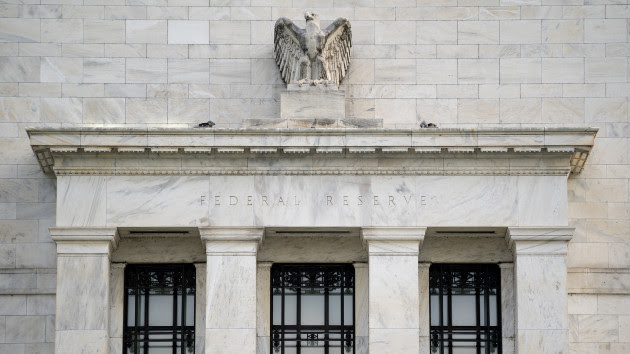(WASHINGTON) — The Federal Reserve will announce an interest rate decision on Wednesday, unveiling its latest policy move amid a near-historic series of rate hikes deployed to fight inflation.
That string of rate increases has coincided with a cooldown of inflation but also has elevated interest payments for everything from credit card loans to mortgages.
The announcement is set to arrive a day after the release of government data showing that price increases slowed slightly last month.
Inflation has fallen significantly from a peak of about 9% last summer but remains more than a percentage point higher than the Fed’s target.
Economists widely expect the Fed to leave interest rates unchanged on Wednesday since inflation has moderated and some areas of the economy have shown signs of a slowing down.
Such a decision would match the choice made by the Fed at its most recent meeting in September, when the central bank paused its inflation fight amid growing optimism that the U.S. could achieve normal price levels without falling into a recession.
Many economists and observers even expect the Fed to begin instituting rate cuts as soon as next year.
Since last year, the Fed has raised its benchmark interest rate at the fastest pace in more than two decades in an effort to slow prices increases.
The rate hikes appear to have put the brakes on the housing market and discouraged businesses from major investments that would carry onerous borrowing costs.
The economy maintained robust employment growth last month but fell well short of the breakneck pace exhibited over the previous year, data from the Bureau of Labor Statistics on Friday showed.
Still, consumer spending has proven resilient. Black Friday sales did gangbuster business as the nation entered a holiday shopping season expected to test shoppers, who account for nearly three-quarters of U.S. economic activity.
Resilient holiday spending could provide additional fuel for the economy as observers hope for continued expansion but fear the downward pressure imposed by interest rate hikes.
Lately, the economy has rebuked such concerns. The gross domestic product grew at an annualized pace of 4.9% over three months ending in September, more than doubling growth of the previous quarter and easing worries about a possible recession, a report from the Bureau of Economic Analysis in October showed.
In recent months, mixed signals from the economy have complicated the Fed’s effort to bring down inflation while averting a recession, an outcome known as a “soft landing.”
In theory, the economy should eventually falter as it becomes more expensive for businesses and consumers to borrow. However, the economy has so far resisted an overall slowdown.
Speaking at a press conference in Washington, D.C. last month, Fed Chair Jerome Powell acknowledged the complex economic picture faced by the central bank.
“Inflation has been coming down but it’s still running well above our 2% target,” Powell said. “Given how far we have come, along with the uncertainties and risks we face, the committee is proceeding carefully.”
While mixed economic data creates significant uncertainty, the status of the Fed’s inflation fight remains clear, Powell said, noting that the task will require a further slowdown in price increases.
“The process of getting inflation sustainably down to 2% has a long way to go,” Powell said. “We remain strongly committed.”
Copyright © 2023, ABC Audio. All rights reserved.












